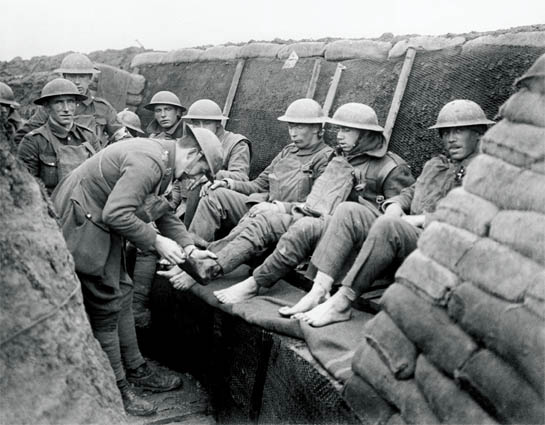Henry Robert Smith was born in Park Cottages, on the boundary of Melton and Ufford, on 14th January 1896; his parent were Henry and Alice Mary (née Potter). Henry Sr. was a carpenter on Edward Brooke’s Ufford Place Estate where, in 1911, Henry Jr. was also employed in Edward Brooke’s house and garden or, as the census enumerator amended, as an “odd boy”.
Henry attested in Ipswich on 16th November 1915 and was initially posted to the 10th (Reserve) Battalion, Suffolk Regiment, which, on 1st September 1916, became the 26th East Anglian Training Battalion. On 13th October 1916, he was sent to the 17th Base Depot – a holding camp for infantrymen – at Etaples in France, before being posted to a battalion in the field. After three weeks training, Henry was posted to join “A” Company of the 1st Battalion, Bedfordshire Regiment, who were in trenches near Richebourg, to the northwest of Bethune. From the war diary entry these trenches are known to have been filled with water and very unpleasant – one set of operational orders dated 12th November 1916 stated:
Trench Foot was a real concern for the men who could spend days standing in water-filled trenches. 
Feet were regularly checked to ensure they were no signs of any problems.
“4. Feet. O.C. Coys will see that all the men’s feet are rubbed with oil before proceeding to the trenches, and a certificate to this effect will be rendered to the Orderly Room.”
In April and May 1917, Henry and the 1st Bedfords were involved in the Battle of Arras, taking part in the attack on La Coulotte, the Third Battle of the Scarpe and the capture of Oppy Wood. They were then sent north to Ypres where, between the 4th and 10th October, Henry and the battalion were in support of the 15th Brigade during the Battles of Broodsneide and Poelcapelle.
On 22nd October, or, the Second Battle of Passchendaele, Henry was involved in the fighting once more. Again, the 1st Bedfords were in reserve. Their role was to relieve the troops of the 13th Brigade on the front line between Reutelbeek and Scherriabeek in the early hours of the following morning. On the 28th October, they were relieved and went into camp at Ridgewood, which is where they were located when the Battle of Passchendaele ground to a muddy halt.
Following this, Henry and the 1st Bedfords went through a period of training and reorganisation, until 11th December, when they were ordered to Italy to assist the Italian army after their disastrous defeat at Caporetto in October 1917. The battalion arrived in Italy on 16th December and remained there until 7th April 1918, when they were posted back to France. Their time in Italy was spent training as the need for reinforcements to assist the Italian army was no longer needed. The enemy forces had advanced as far as the Piave river, at which point the German troops were withdrawn and sent back to the Western Front.
On their return to France, the 1st Battalion Bedfordshire Regiment were in trenches near Fremicourt. Battle orders were received: they were to support the 1st Norfolk’s and 1st Cheshire’s in their advance to capture the village of Beugny on 2nd September 1918. While in trenches, the battalion advanced in support of the attack and came under heavy fire. There were ninety-four other ranks either killed, wounded or missing. Henry was one of those injured by shrapnel in his left knee. He was taken to the No.4 Casualty Clearing Station (CSS) at Beaulencourt and then via the 21st Ambulance Train to first the No.2 CSS and finally the No.15 CSS at Anvin.
Henry remained with the No.15 Casualty Clearing Station until 30th September, when he was sent to the “L” IBD (Infantry Base Depot) at Etaples. On 7th October, he was posted back to join his battalion again in billets at Neuville, undergoing training. A month later on 9th November, Henry was granted leave to travel back to England until 23rd November and was at home when the Armistice was declared. Once his leave was over, he rejoined his battalion in France for a final time and returned to England on 28th February 1919 for demobilisation. For his war service, Henry received the British War and Victory Medals.
In 1924, Henry married Mabel Alice Farthing. The 1939 register shows him working as a gardener and living in Old Mill Cottage, Melton. He died in 1950 and is buried at Melton Old Church.
